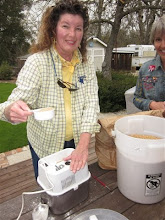 3. Fill mold: Coat vessels with mold-release spray. Pour mixture into the outer mold to a 1-inch depth for smaller vessels or a 2-inch depth for larger ones. Set interior mold inside, centering it (you can fill it with sand to steady it). Continue adding mixture between vessels. Tap exterior with a rubber mallet to minimize bubbles. Cover with plastic; let set.
3. Fill mold: Coat vessels with mold-release spray. Pour mixture into the outer mold to a 1-inch depth for smaller vessels or a 2-inch depth for larger ones. Set interior mold inside, centering it (you can fill it with sand to steady it). Continue adding mixture between vessels. Tap exterior with a rubber mallet to minimize bubbles. Cover with plastic; let set. Homemade Yogurt topped with...

Homemade Granola!


Thursday, April 26, 2012
Farmgirls Love Hyper Tuffa...
 3. Fill mold: Coat vessels with mold-release spray. Pour mixture into the outer mold to a 1-inch depth for smaller vessels or a 2-inch depth for larger ones. Set interior mold inside, centering it (you can fill it with sand to steady it). Continue adding mixture between vessels. Tap exterior with a rubber mallet to minimize bubbles. Cover with plastic; let set.
3. Fill mold: Coat vessels with mold-release spray. Pour mixture into the outer mold to a 1-inch depth for smaller vessels or a 2-inch depth for larger ones. Set interior mold inside, centering it (you can fill it with sand to steady it). Continue adding mixture between vessels. Tap exterior with a rubber mallet to minimize bubbles. Cover with plastic; let set. Gretchen's A to Z Bread
Makes 2 loaves
Mix together in a large mixing bowl:
3 eggs, 1⁄2 cup applesauce, 1⁄2 cup oil, 1 to 1 1⁄2 cup sugar (the original recipe calls for two cups; I have used 1 c sugar, or 1 c brown sugar, or 3⁄4 cup honey)
Add to bowl and mix in:
1⁄2 tsp baking powder, 1 tsp salt, 1 tsp baking soda, 3 tsp cinnamon, 3 tsp vanilla
Add in:
3 cups flour, 1 cup nuts (optional), and 2 cups A to Z (I have used chopped apples, mashed bananas, shredded carrots, pumpkin, mashed persimmons, and zucchini – you can use all of one or mix them)
Bake in two prepared loaf pans at 350 degrees for about 55 minutes, until done.
You can check out Gretchen's OTHER delicious Zucchinni recipes as, she so well put, life was giving her zucchini.....Chocolate Zucchini Muffins, Zucchini Pasta, Zucchini Walnut Cake, Zucchini Pickles, etc. on her blog at Pappasfam.blogspot.com
Back Yard Salad Garden




















No comments:
Post a Comment